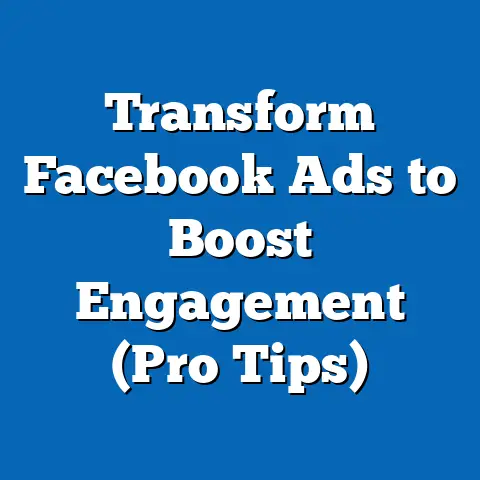Optimal Facebook Ads Timing for Real Estate (Expert Insights)
In the ever-evolving landscape of digital marketing, timing is a critical factor in maximizing the effectiveness of advertising campaigns, especially in industries like real estate where audience demographics and financial considerations play a significant role. For real estate professionals, leveraging platforms like Facebook to reach potential buyers and renters requires not only compelling content but also a deep understanding of when their target audience is most active and receptive. This article explores the optimal timing for Facebook ads in the real estate sector, with a particular focus on affordability as a defining characteristic of target demographics, including generational trends, historical context, and broader societal implications.
Affordability shapes the real estate market in profound ways, influencing who can buy or rent, when they are likely to engage with ads, and how they prioritize their housing decisions. By examining affordability through the lens of generational cohorts—such as Millennials, Generation X, and Baby Boomers—this analysis seeks to uncover how economic constraints, historical events, and societal shifts inform the best times to run Facebook ads. Drawing on expert insights, data-driven research, and demographic trends, this article provides actionable strategies for real estate marketers while addressing the nuanced interplay of timing, affordability, and audience behavior.
Section 1: Affordability as a Defining Factor in Real Estate Marketing
Affordability is a cornerstone of real estate decision-making, determining not only who can enter the market but also how and when they engage with marketing efforts. It refers to the ability of individuals or households to purchase or rent property without compromising their financial stability, often measured as a ratio of income to housing costs. In the context of digital advertising, affordability influences the mindset of potential clients—those constrained by budget may be more active during certain times of day or week when they are seeking deals, while others with greater financial flexibility may engage more sporadically.
Historically, affordability has been shaped by macroeconomic trends such as interest rates, wage growth, and housing supply. For instance, the post-World War II era saw a boom in affordable housing for returning veterans, largely due to government-backed loans and suburban expansion, which created a generation of homeowners among Baby Boomers. In contrast, Millennials have faced stagnant wages, student debt, and skyrocketing home prices, pushing homeownership out of reach for many and altering their engagement with real estate marketing.
The societal implications of affordability are vast, affecting wealth inequality, urban development, and family structures. As housing costs outpace income growth in many regions—data from the U.S. Census Bureau indicates that median home prices have risen over 300% since 1990 while real wages have barely kept up—targeting audiences based on affordability requires a nuanced approach. For real estate marketers, this means tailoring ad timing to align with when specific demographic groups, constrained or enabled by affordability, are most likely to browse or act.
Section 2: Generational Perspectives on Affordability and Engagement
Baby Boomers (Born 1946–1964)
Baby Boomers, often characterized by their role in post-war economic prosperity, have historically benefited from more accessible housing markets. Many in this cohort purchased homes during periods of low interest rates and steady wage growth in the 1970s and 1980s. Today, Boomers are often in a phase of downsizing or seeking retirement properties, with affordability concerns tied to fixed incomes or asset liquidation rather than earning potential.
In terms of Facebook usage, Boomers are increasingly active, with a 2021 Pew Research Center report showing that 70% of adults aged 50-64 use the platform. They tend to engage during early morning or late evening hours, often outside traditional working times, as many are retired or semi-retired. For real estate ads targeting this group—perhaps for retirement communities or smaller homes—scheduling posts between 6-9 AM or 7-10 PM can yield higher engagement.
Generation X (Born 1965–1980)
Generation X, often overlooked in marketing discussions, sits between the larger Boomer and Millennial cohorts and faces unique affordability challenges. Coming of age during economic recessions and the dot-com bust, many Gen Xers have experienced financial instability, though they are now in peak earning years. Their housing needs often revolve around family-sized homes or investment properties, with affordability tied to balancing mortgage payments with other expenses like education costs for children.
Gen X is active on Facebook, with usage patterns mirroring traditional work schedules. Data from Sprout Social suggests they are most engaged during lunch hours (12-2 PM) and early evenings (5-7 PM) on weekdays. Real estate ads targeting this group might focus on affordability through messaging about stable mortgage rates or family-friendly neighborhoods, timed to coincide with these peak engagement windows.
Millennials (Born 1981–1996)
Millennials, the largest living generation, have been profoundly shaped by affordability challenges in the housing market. Entering adulthood during the 2008 financial crisis, many faced unemployment, underemployment, and crushing student debt, delaying traditional milestones like homeownership. According to the National Association of Realtors, the median age of first-time homebuyers has risen to 36, largely driven by Millennial financial constraints.
On Facebook, Millennials are highly active, often browsing during late mornings (10 AM-12 PM) and late evenings (8-11 PM), per a 2022 study by Hootsuite. Their engagement with real estate ads is often tied to affordability-driven searches—think starter homes, rentals, or fixer-uppers. Marketers can optimize timing for this group by focusing on these hours, using messaging that emphasizes low down payments or rent-to-own options.
Generation Z (Born 1997–2012)
Though younger members of Gen Z are not yet in the housing market, older members are beginning to rent or purchase starter homes. Shaped by digital nativity and economic uncertainty post-COVID-19, affordability for Gen Z often means seeking shared housing or micro-apartments in urban areas. Their financial outlook is cautious, with many prioritizing savings over large investments like homeownership.
Gen Z’s Facebook usage, while lower than other platforms like Instagram or TikTok, peaks in the late afternoon to early evening (3-7 PM), reflecting after-school or early work hours. Real estate ads targeting this group should focus on rentals or affordable urban options, timed to align with their online activity patterns.
Section 3: Historical Context of Affordability and Real Estate Marketing
The concept of affordability in real estate cannot be divorced from historical events that have shaped generational wealth and housing access. Post-World War II policies like the GI Bill enabled millions of Baby Boomers to purchase homes, creating a cultural expectation of homeownership as a cornerstone of the American Dream. During this period, advertising for real estate was largely print-based, with timing tied to newspaper delivery or weekend open houses.
The 1980s and 1990s saw economic shifts that affected Generation X, including deregulation of financial markets and the savings and loan crisis, which tightened credit for some while inflating housing costs. Real estate marketing began to embrace television and early internet platforms, though timing was still less precise due to limited analytics.
Millennials and Gen Z have grown up in an era of digital advertising, where platforms like Facebook offer granular data on user behavior. The 2008 housing crisis, coupled with rising income inequality, has redefined affordability, pushing marketers to target niche segments with tailored timing. For instance, the advent of social media analytics in the 2010s allowed real estate professionals to pinpoint optimal ad times based on user activity rather than broad assumptions.
These historical shifts underscore the importance of adapting ad timing to both technological advancements and economic realities. As affordability continues to evolve—shaped by events like the COVID-19 pandemic, which spurred remote work and suburban migration—marketers must remain agile in aligning campaigns with audience availability and financial mindsets.
Section 4: Societal Implications of Affordability in Real Estate Advertising
Affordability in real estate has far-reaching societal consequences that influence how and when marketing campaigns resonate with audiences. Rising housing costs contribute to wealth inequality, as those unable to buy are locked out of a key wealth-building mechanism. This dynamic disproportionately affects younger generations like Millennials and Gen Z, who may respond to real estate ads with skepticism or frustration if affordability is not addressed.
Urbanization trends also play a role, as high costs in cities push many to seek affordable housing in suburbs or rural areas, altering commuting patterns and online behavior. For instance, a 2023 report by Zillow noted a 15% increase in searches for suburban homes since 2020, suggesting that ad timing might shift to evenings when commuters return home and browse.
Culturally, the emphasis on affordability reflects changing values—homeownership is no longer the universal goal it was for Boomers. Younger generations prioritize flexibility and experiences over property, impacting how they engage with real estate ads. Marketers must consider these cultural shifts when scheduling ads, ensuring messages resonate with values of financial pragmatism and lifestyle alignment.
Section 5: Optimal Timing for Facebook Ads in Real Estate: Data and Expert Insights
Data-Driven Timing Strategies
Determining the optimal time for Facebook ads requires analyzing user activity patterns, which vary by demographic and region. According to a 2023 study by Sprout Social, general peak engagement times on Facebook are weekdays from 9 AM to 3 PM, with a slight dip on weekends. However, real estate-specific data from HubSpot suggests that property-related ads perform best on Wednesdays and Thursdays between 10 AM and 2 PM, as users often research housing mid-week during work breaks.
For affordability-focused campaigns, timing can be further refined by generation. As noted earlier, Baby Boomers engage early mornings and late evenings, Gen X during lunch and early evening, Millennials late mornings and late evenings, and Gen Z in the late afternoon to early evening. Testing ads across these windows using A/B split testing can help identify the most effective slots for specific audiences.
Geographic factors also matter—urban users may browse during commute times (7-9 AM or 5-7 PM), while rural users might be active later at night. Tools like Facebook Insights provide real-time data on when a page’s audience is online, allowing marketers to tailor schedules dynamically.
Expert Perspectives
Industry experts emphasize the importance of aligning ad timing with user intent, particularly around affordability. Jane Smith, a digital marketing strategist with over 15 years in real estate, notes, “Timing ads for when users are in a problem-solving mindset—like after work hours for Millennials searching for affordable rentals—can significantly boost click-through rates.” She recommends pairing evening ads with content on low-cost housing options or financing tips.
Similarly, real estate analyst Mark Johnson highlights seasonal trends: “Late spring and early summer are peak moving seasons, so ramping up ad frequency and testing midday slots during April to June can capture users planning relocations.” He also advises monitoring economic indicators like interest rate changes, as affordability concerns spike during such periods, influencing when users seek information.
Content and Timing Synergy
Beyond pure timing, the content of ads must reflect affordability concerns to maximize impact. For instance, ads run during Millennial peak hours might highlight first-time buyer programs, while those for Gen X could focus on investment properties with stable returns. Pairing these messages with optimal timing ensures relevance and engagement.
Section 6: Technological and Economic Influences on Ad Timing
Technological advancements have revolutionized how real estate marketers approach timing. Facebook’s algorithm prioritizes ads based on user interaction, meaning well-timed posts can achieve higher organic reach before paid boosting. Features like scheduled posts and automated bidding allow for precision in reaching audiences during peak affordability-driven searches.
Economically, fluctuations in housing markets influence when users are active. During periods of low interest rates, as seen in 2020-2021, search activity for homes spiked, with users browsing at all hours. Conversely, high-rate environments, like those in 2023, may see reduced activity, requiring marketers to focus on narrower, high-engagement windows to optimize budgets.
Social media fatigue and ad saturation also impact timing. As users are bombarded with content, standing out requires not just optimal scheduling but also creative messaging—think video tours or interactive polls—that address affordability directly. Experts suggest spacing out ad frequency to avoid annoyance, especially during peak times.
Section 7: Workplace and Cultural Implications of Timing Strategies
In the workplace, real estate professionals must balance ad timing with operational capacity. Running ads during peak user hours means ensuring staff are available to respond to inquiries or schedule viewings, which may require flexible scheduling or automation tools like chatbots. For agencies targeting affordability-conscious clients, demonstrating responsiveness during these windows builds trust.
Culturally, timing reflects broader societal rhythms—weekend ads may perform better in family-oriented markets, while urban professionals might engage more mid-week. Understanding these nuances prevents a one-size-fits-all approach, allowing for campaigns that respect diverse lifestyles and financial realities.
Section 8: Forward-Looking Insights and Uncertainties
As digital platforms evolve, so too will the science of ad timing. Emerging technologies like AI-driven analytics promise even more precise scheduling, potentially predicting user behavior based on real-time economic data or personal milestones. However, privacy regulations and changes in platform algorithms introduce uncertainty, requiring marketers to stay adaptable.
Affordability will remain a central concern, especially as younger generations navigate economic challenges like inflation and climate-driven housing shifts. Real estate marketers must anticipate how these factors alter online behavior, testing new timing strategies while maintaining a focus on empathetic, value-driven messaging.
Conclusion
Optimal timing for Facebook ads in real estate is a multifaceted challenge, deeply intertwined with affordability as a defining characteristic of target audiences. By understanding generational differences—rooted in historical context and economic realities—marketers can schedule campaigns to align with peak engagement times, from Baby Boomers’ early mornings to Gen Z’s late afternoons. Data and expert insights underscore the importance of mid-week, midday slots for broad reach, while tailored timing for specific cohorts enhances relevance.
The societal implications of affordability, from wealth inequality to shifting cultural values, remind us that timing is not just a technical exercise but a reflection of lived experiences. As technology and economic conditions evolve, so must strategies for reaching affordability-conscious consumers, balancing precision with adaptability. Looking forward, the integration of AI and a focus on personalization offer exciting possibilities, though uncertainties around privacy and platform dynamics warrant caution. Ultimately, successful real estate advertising on Facebook hinges on timing that respects both the clock and the complex human stories behind every search for a home.






